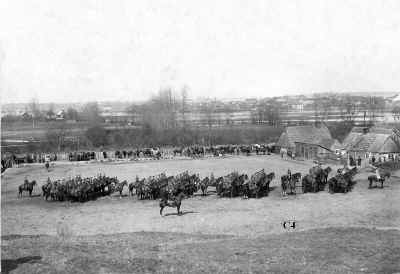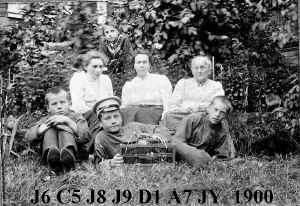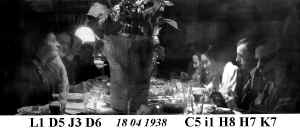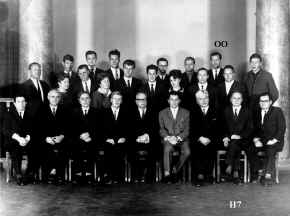FATE OF SANCT-PETERBOURG KIN EKIMOV
The founder of Peterbourg kin Ekimov, A1, came to Sct.-Peterbourg from Siberia, according to family legend.
In the whole kin he was the single authentic ethnic Russian who left his name to all his descendants. The origin of his wife, A2, may be doubted:
Although she should have been Orthodox, her features, as one can judge from her portrait, let suspect some Moldovian or Caucasian (Georgian) origin.
With all probability A1
originated from free peasants, but his official name Ekim Ekimovitch Ekimov
showed the typical absence of a family name tradition as was usual for Russian
peasants before abolishing serfdom in 1861: Ekimov obviously meant
descent from his father Ekim, but a "noble" patronym Ekimovitch
was repeatedly added in Peterbourg when A1 made his career there. With no doubt,
his wife Paraskeuve (Praskovia) Yakovlevna, A2, in the same
way was named Yakovleva (daughter of Yakov) before her marriage.
The name Ekim is theophoric (‘God-bearing’) and goes back to the
Church Orthodox Ioakim what is a Grecianised form (the Latinised being Joachim)
of Hebrew Yehoyakim ‘Let YHWH stand him!’.
A1 began as a courier but ended as steward at an estate of Dukes
Gagarin. Nevertheless, he did not succeed to ascend prosperous middle class
and had to let his sons attend a school for poor children. To become typical
real Peterbourgian one had to make career at state service as well as to follow
Western norms of life. In Sct.-Peterbourg the westernisation meant marrying a person of Western origin (it were Kurland, Poland, Germany,
Sweden, France, England and other Western countries, from which ca. 60 % of ca. 20 % constant residents
of Sct.-Peterbourg originated, most of them being
German-speaking Lutherans, in
the beginning of 19th c.). This was the case of the 2nd generation of Ekimov in
Sct.-Peterburg.
Both conditions, the state service and marrying a person of Western origin, were fulfilled by Basily Ekimov (1832-1914?), A6, son of A1. A6 married a woman, Anna, A7, taken to Sct.-Peterbourg together with her sister Julia by their mother Anne Marie Schenken, A3, née Palmen, from Germany.
With all probability they were of the middle or even of the lower class, bread-winner of the family (Paul Schenken) having had died before.
The process of westernisation of Peterbourg intellectuals of the Russian origin may be illustrated by the fate of Julia, sister of A7, who married a known Russian actor Khodotov (1878-1932; daughter of this marriage Anna Bagrikova, as well as daughter of the latter, Kira, are indicated in the Table of Common Genealogy under EX, L4, both having been frequent guests at the family of C4, son of A6, in later epochs). Michael, AN, brother of A6, had not distinguished himself in any brilliant career, what is seen from his daughter Aglaida, D6, having married her cousin Michael, D5, a successful military officer, this strange marriage appearing to be very good for her. Such marriages could not be a tradition under strict orthodox rules, therefore the reasons, if not only love, had to be very serious. In any case marriage to a westernised half-German was a kind of westernisation too. As for Eugenia, D7, sister of D6, her westernisation was the wedding with Yegore Zakrzewski, a military officer of the Polish origin.
Basily, A6 ended his successful career as State Counsellor and Head of Division at the Mining Department of the Ministry of State Possessions.
This was crowning of the long way which he began in 1848 as a
clerk at the Department for Coal- and Salt-Mining after he had finished a school
for poor children of the Royal Philanthropic Society.
The second stage of his career, a title of College’s Registrar, was achieved
in 1864.
Further regular stages were:
Officer of the Accounts - in 1865,
Senior Assistant of the Head of Division - at the end of 1865,
Government Secretary - 1867,
Bearer of the Order of St. Stanislaus of the 3rd degree - 1868,
College’s Secretary and Order of St. Ann of the 3rd degree -
1870,
Titled Counsellor - 1874,
College’s Assessor - 1876,
Staff Officer of the Ministry - 1878,
mission at counting office of the Department - 1879,
Court Counsellor - 1881,
acting Head of Division - 1884,
Head of Division and College’s Counsellor - 1885,
Order of St. Stanislaus of the 2nd degree - 1886,
State Counsellor - 1890,
pensioned with 600,- Roubles a year - 1892.
Although having made an excellent career and being bearer of the said orders as well as of the French Commandor Cross of the Honour Legion and Monte-Negro Order of Daniel of the 3rd degree, he was not registered as estate possessor. Therefore a question arises about origin of the family estate in Gorodishche near Luga in the district of Novgorod (railway station Utorgosh), whether it belonged to his daughter Olga, C6 (born in 1863), who was a constant resident of Gorodishche together with her 2 sons and daughter. According to the Personal file of A6, Olga was living with him together with her children because of the severe disease of her husband. Since one of her sons was said to be "inadequate", her husband merchant Oparin had been possibly a patient of some psychatric hospital for many years in his turn, but Olga's parents considered her legacy to be under the guardianship of all the relatives.
Nevertheless other reasonable
suppositions are not excluded. When Feodore, D8, the eldest son of A6
and A7, married a Georgian princess Nino Eristavi, DX, he brought
her to Gorodishche. Since a comfortable flat was at his disposal in
Sanct-Peterbourg undoubtedly, what could be the reason of bringing his young wife
somewhere if that place was not their own estate? It seems plausible that the
estate might have been bought as a dowry either by the father of DX poet Prince Rapiel Eristavi, B8,
or even by the uncle of DX Lieutenant General Prince Kiazo Eristavi,
superior of Feodore, who had introduced the latter to DX with all probability
and who was surely richer than his cousin poet. Since Kiazo Eristavi was not any
great millionaire in his turn too, the estate was not gorgeous in any
way.
A6 was the first and, together with his wife, the last buried in their
family chapel there. After 1917 the chapel was rubbed out by peasants and bones
of A6 and A7 scattered to become finds for village dogs.
It is strange that A6 is
not found in ‘All Peterbourg’ of 1896, 1900, 1902 and other years of the end
of the 19th - the beginning of the 20th c., when A6 was
“prescribed to Peterbourg 1st Kazan-Part” according to his
Personal file. His address is mentioned as Bolshaya
Konyushennaya, 5-14 in
this file. This address must be checked up by analyzing administrative division
of Sct.-Peterbourg before the beginning of the 20th c. At least at
the beginning of the 19th c. buildings were numbered in another way,
as their post address (according to a street) was. In any case, A6 “was
prescribed” by Sct.-Peterbourg Police Department, i.e. the numbering may
reflect some administrative-police division, but not any post addresses to
streets. The flat “14” obviously corresponds to C4’s later flat on 2,
Bolshaya Konyushennaya Str. On the other hand, the address of A4’s son
Constantin is pointed out at 2 places in the same years 1908 and 1911 in ‘All
Peterbourg’: on 5, Catherine-Canal and on 2, Bolshaya Konyushennaya
Str. Both flats belonged to (or were rented by) the Court Stables
Department. On the other hand, A6 directed his sons to study at Nicolas Cavalry
School. This allows to presume that A6 already had had contacts with the Court
Stables Department before his son, C4, was appointed there. In case he was a
sub-renter of the Stables Department on 2, Bolshaya Konyushennaya
Str., this probably rid him of obligation to declare his address in ‘All
Peterbourg’. Only about 1908 his son, C4, still dwelling on 5,
Catherine-Canal, becomes the main renter of his father’s flat No 14, but C4
also rents his 1st flat on 2, Bolshaya Konyushennaya Str. (not No 14
on the 1st storey!). Seemingly he moves from the worse flat on
the Catherine-Canal to the flat No 14 only after his father's death. As for the
second ("first") flat on the ground floor of the same building on 2,
Bolshaya Konyushennaya Str., he surely gave it up after the February
revolution 1917. If these presumptions are true, then the address 2, Bolshaya
Konyushennaya Str. 14 must be regarded to have been a unique address of the
kin of Ekimovs since the last quarter of the 19th c.
Basily, A6, and Anna, A7, had 5 sons and 4 daughters.
Several legends, telling about A6 and A7, survived. A6 as if used to cite a Russian translation of the student Hymn 'Gaudeamus igitur', namely the verse Vremya lyotsya tak, kak rechka, Den’ prokhodit tak, kak chas, Chelovek gorit, kak svechka, Dunul veter - on pogas ("Time streams as a river, Day passes as an hour, A man burns as a candle Being out with the puff of the wind"). C4 said as if this was A6’s own verse. Nevertheless other verses are known from various sources, but the text of ‘Gaudeamus Igitur’, artificially propagated at universities, was popular at the end of the 19th c. in various Russian versions having nothing to do with the Western student tradition (cf. about Constantin.3 Klosse).
The theme of the burning candle, in a strange way liked by A6, reveals a frightful relation to A7. Of A7 it was narrated as if she died in Gorodishche when her husband, A6, was in Sct.-Peterbourg. That night he dreamt her holding a nice flat candle-stick with a burning candle, and she said to him: "Thieves wanted to burgle our house but I turned them out". It appeared that thieves really broke in the house at night but, seeing the corpse, were frightened and fled. The story was told by C4, but H7 (many years later) said as if it was about a maidservant, not about A7. In any case it was A6 who dreamt this dream. The small flat bronze candle-stick with an artistic handle and a motley encrusted enamel ornament is now in the family of Q3. The candle-stick fell to H7's share from Tamara, S8, daughter of his cousin Nina, L1, who was daughter of princess Nino, DX. It was S8 who witnessed the identity of the said candle-stick and that dreamt by A6. Since, therefore, the candle-stick had been in Gorodishche and later - at a granddaughter of the princess, the character of the candle-stick being oriental, one may conclude, that it was a possession of princess Nino, taken from her native estate at Kistauri as a memory of her childhood. The connection between the candle-stick and the frightful history might have appeared as a result of dying remorse of A7 who recollected her cruel treatment of her daughter-in-law. It seems to be highly credible that such remorse could provoke a real prophecy: it was a BURNING CANDLE left on the loft of the estate house of Gorodishche several years later, which caused a conflagration and burning down of the entire house.
It was also narrated about A6 that he liked to enjoy sweets in his last years. In addition, his son Constantin, C4, told of some family ghost, a "White Woman", who as if visited his ancestors A6 and A1 before their death. No "White Woman" appeared before the death of C4 himself in 1959. But there were really many "white women" in a hospital where his son i7 died in 1992.
Sons of A6 and A7
As mentioned, all 5 sons of A6 and A7 became cavalry officers. It seems that at one period of time all of them belonged to the 5th Cavalry Division, mostly used to protect the Western frontier of the Empire. Unfortunately, this also meant executing control over countries seized by Russia in the 18th c. The 13th Kargopol dragoon regiment, in which the youngest brother Koka Ekimov, C4, served, was one of the strongest occupation units in Poland. It appeared in Konin namely as a result of the suppressed revolt of 1863. Nevertheless one cannot accuse people who honestly fulfilled their duties. Those who were Peterbourgians, were Europeans. They had sensitive souls and noble hearts. At appropriate moment there came fighters for liberation and independence of enslaved peoples. One of such persons was the famous hero of Finland and its future President Carl Gustaf Mannerheim.
Koka, Basily, Michael and Feodore Ekimov, Skierniewice 1898.
The eldest of the brothers, Feodore Ekimov (1860), D8, made the best career: he met 1917 as retired colonel of the General Staff.
Feodore in the "first" flat on Bolshaya Konyushennaya. In the mirror: his father A6.
His first wife was Nino Eristavi, DX, daughter of Georgian poet Prince Rapiel Eristavi, B8.
On these grounds D8 tried to
earn a title "Prince Eristov-Ekimov" (Prince
Eristov, i.e. George (Giorgi, Kiazo) Eristavi,
B8's cousin, was Lieutenant-General, Commander of the 5th
Cavalry Division at the end of the 19th
c.; with all probability this was the reason of D8's relation to Georgia as well
of his successful career). D8 took his wife DX to moist northerly Gorodishche where
she was made fun of by the aged German commoner A7 who ill-treated the unlucky Georgian
princess, her daughter-in-law, in such way. As a result, DX fell ill and died of
tuberculosis in her father's house in Kistauri, Kakhetia, in 1889.
Of this 1st
marriage D8 had a daughter Nina, L1.
Nina in Gorodishche in 1901. In the mirror: her uncle Koka taking a shot.
C4 and C5 even named their second child Nina (unfortunately, the child died in the same 1905). L1 married a military officer Nicolas Pyatnitsky, LX, with whom she had a daughter Tamara, S8. After 1917 L1 married a Red Army officer Ilia Godlewski , L2.
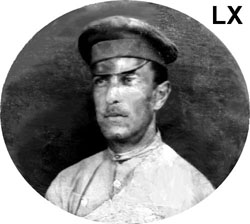
L1 died in 1943 when she came to know that her and Ilia's young son Donat, S9, fell in a war action. L1's and LX's daughter Tamara Pyatnitsky, S8 (in marriage - Romanov) - competed with her mother in beauty, but she resembled a Georgian even much more than her mother, daughter of a Georgian DX. In 1920s she even became a cinema actress (film “Decembrists” of which all copies perished during World War II).
Tamara Pyatnitsky with her mother Nina Godlewski.
S8 dreamt Georgia during all her life and succeeded to visit Kistauri, house of her great-grandfather poet Rapiel Eristavi, B8, and her grandmother Nino, DX, his daughter, before the World War II. She also acquired friends in Tbilisi before the war. In her last years she resumed her contacts with Georgia due to Q3, who had visited Tbilisi and Kistauri. S8 died of lungs cancer in poverty, under the corridor stairs of one of Leningrad hospitals (there was no free place in any ward) on 25 August 1981. The life of her brother Donat Godlewski, S9, was short.
Donat in childhood in garments of a Georgian warrior.
Since childhood S9 dreamt a military career. He was a cadet of a tank military school when the World War II broke. He jointed the army as a lieutnant but was killed by shell-splinter in tank action at Kursk (he had just showed himself out of the trap door in a moment) in 1943.
Donat (2nd from the left) with his friends cadets.
His father L2 was Jewish. Nevertheless S9 chose the kin of his great-grandfather Rapiel Eristavi, B8: similarly to S8, he romanticised Georgia and considered himself to be a Georgian.
After the death of Nino, DX, Feodore Ekimov, D8, married again. His second wife Else, D9, was a German.
Contrarily to A7, she surely originated at least from the middle class and still had relatives in Germany. In twenties she succeeded to flee from the Soviet Union to Germany, taking her and D8's son Georg (Goga), L3, there.
Feodore with his son Goga after 1917.
It was narrated, as if L3 had been engaged as an engineer at Messerschmitt works in Germany, nevertheless no traces have been found.
The third wife of D8 Ekaterina, E1, was Ethnic Russian.
This was already a Soviet time. D8 and E1 had no children. D8 having died short before the war, E1 outlived him in ca. 20 years but she remained alien to other representatives of the kin.
D8 escaped Bolshevik repressions due to 2 lucky chances: 1)
being a reservist in 1917, 2) having a distinguished "red" brother D5.
D8 was a good amateur painter. Several pictures by him, 2 of them being Crimea
oil-paintings ca. 28 x 33 cm, have been preserved in the family of Q3 in Kaunas.
These paintings are heritage of S8.
Kokorev's estate in Makhalatka
Michael Ekimov (1865-1941?), D5, made a brilliant military career and was known as winner of many prizes, including Emperor's prizes, in races.
He was beloved by women - his father even had to rid him (asking to order him off Sct.-Peterbourg) of dangerous competition with Successor Nicolas Gottorp Romanov in a romance with ballerina Matyùda Krzesiñska. His risky jokes reveal his merry and adventurous nature. Once, when D5 and his younger brother Koka, C4, were waiting for a train at a railway station, there appeared a military general, who began to censure C4 having not buttoned up collar of the coat (this might happen in 1903 when C4 was a cadet of Emperor Nicolas' Cavalry School). Koka blushed, and turned pale, and shuddered, of course. Their train having started, through the window Michael made a long nose at the general, who had remained on the platform. D5 met 1917 at the German front as a lieutenant-colonel (rotmister), commander of the 38th Vladimir dragoon regiment.
Together with his son K6 he joined the Bolsheviks and began his service in the Red Army. During following Civil War he became Inspector of Kazan Cavalry District. At that time his wife Aglaida, D6, had to be in Kazan too (as seen from their Christmas card, sent to family Henkel in Konin at the end of 1910, D5 served in Kazan in some way before 1914 too).
Goria in childhood.
At the same time their son Georgy (Goria), K6, was commander of a cavalry division in Crimea. He was killed at Perekop in battle against the White Guardsmen of General Wrangel in 1920. His remains were brought to his father to Kazan. It was during a ball when D5 was called out to get to know about death of his single son. He fainted. K6 was buried in Kazan.
It is paradoxical that K6 contributed to the destruction of Sanct-Peterbourg
with his participation in struggle against General Wrangel, who was ideologist
of imperial Sanct-Peterbourg. Peter Wrangel (1878-1928)
was a true Peterbourgian and one of those rare representatives of the elite for
whom Sanct-Peterbourg was not any Russian
capital but the Western Metropolis of Russia. The Empire itself was not Russian but
Peterbourgian. Russia was only an economic supplement to Sanct-Peterbourg. These
were real ideas which Wrangel defended against revolted Russia, an alien race, not any alternative political force (as if Bolshevik). It is clear
that representatives of the kin Ekimov were not westernised to such a degree to
understand and adopt these ideas. Or was the last decision of D5 to remain in
Paulovsk in 1941 (see further) his repentance for his service in Bolshevik army?
After the Civil War D5 retired (this saved
him from Stalin's repressions of the thirties) and was offered by Bolshevik
authorities to choose for himself and his family any villa he only wanted. D5
chose former Balashov's villa in Paulovsk, imperial residence suburb near
Sct.-Peterbourg, in a small estate park against the BIP ('Emperor Paul I's
Bastion')-Fortress. He moved there together with his wife Aglaida, D6,
and his daughters Vera, K7 and Galina (Gulia), K8.
Aglaida before 1917.
Vera at Balashov's villa in Paulovsk.
Love to Paulovsk went back to his father A6, who occasionally rented summer "datchas" there (at least once, together with his son C4, in the site called Novaya Ves). Later other relatives, similarly to many families and wives of servicemen officials, spent their summers in Paulovsk. Paulovsk also was a place of creative work of David Visconti, an architect and author of the Visconti's Bridge in the Park, as well as of his brother Carlo Domenico Visconti, the author of Mausolem there. David was great-grandfather of Eugeny Visconti, C7, Vice-Director of the Department of Common Affairs of the Ministry of Foreign Affairs and husband of D5' sister Maria, C6 (see Visconti).
D5 with his brother Koka (left) and daughter
(right)
in salon of the villa (the 1st
floor), 1937.
D5 and D6 had also daughter Maria,
K5, second child after Goria K6, and besides him, also daughters Vera, K7, and
Gulia, K8.
Unfortunately, Maria died in childhood after she had drunk a whole bottle of
strong medicine, left in an inappropriate place by mistake.
After the family had moved to Paulovsk, Gulia, K8, died of tuberculosis. She left a son Leonid (Lyodia) Poznianski, S6, future cellist, further brought up by his aunt Vera, K7.
Short after the war Vera for herself died of tuberculosis.
Since neither D5, nor his wife D6 then existed, further fate of Leonid is
unknown.
When World War II broke out, K7 fled to the town together with Leonid, but D5
and D6 remained in Paulovsk,
Of 3 other sons of Basily, A6 and Anna, A7, Ekimov, i.e. Alexey, D4, Basily, C8, and Constantin, C4, Alexis, D4, went to White Guards and of his fate only the name of his son Alexis and his wife Lydia are known.
As for Basily, C8, he kept to the tradition of Sanct-Peterbourg and married a Peterbourg German Olga Ferdinandovna, C9.
He did not join the Bolsheviks and even remained some time with the "Whites". Therefore the fate of his family was not easy in Soviet times. Of his children Feodore, J6, and Anna, J5, the son became a sportsman in wrestling and won prizes. He died in sixties but his daughter Anna, RX, married some Ratshabli, the fate unknown.
Constantin Ekimov (Koka, 1873-1959), C4, the youngest son of A6, enlisted in military service as a volunteer cornet on 21 February, 1892, but he finished Emperor Nicolas' Cavalry School in 1903.
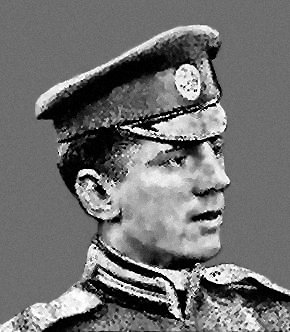
This was the last year when future hero of Finland Carl Gustaf E.Mannerheim studied at the same school.
It is interesting that the way of C4 developed close behind that of C.G. Mannerheim - after 1903 this was probably due to protection of this great school-mate. In 1892 C4 began his career in the 13th Kargopol dragoon regiment of the 5th Cavalry Division located on the West frontier of the empire.
Koka Ekimov on Gravelota
having won
the prize of the 5th
Cavalry Division.
At that time C.Mannerheim had just finished his "black dragoon" service there a year earlier, in 1891. The 13th regiment was quartered in Konin, Poland, since the uprising of 1863:
In Konin C4 came to know the family of the Lutheran pastor Karl Henkel (1841-1915), A8: his wife Martha, A9, daughters Maria Sophie (Dukhna, 1878-1962), F3, Martha Julia (Bibi, 1882-1965), C5, Magdalene (Nyunia, 1888-1980), E2, sons Karol (Bucynty, 1885-1974), E4, and Aleksander, E6 (see Henkel). 3 of these 5 children later came to Sct.-Peterbourg: E4 as a student, but C5 as wife of C4, while F3 followed her sister and later married Constantin.3 Klosse, F2, a violinist of Sct.-Peterbourg Maria Theatre (see Klosse).
His highly privileged position enabled C4 to evade mobilisation to the front in 1914: it seems highly incredible as if his military service was stopped in 1914 and he was engaged as Instructor of Riding Section of the Stable Department up to 23 April, 1920, as he wrote in his application to Soviet authorities with a hope to be granted a pension in 1954. Only continuing a military service at the Court a healthy 41-old man could evade mobilisation in 1914. It was only due to his being in the military service even in October 1917, that his candidature was proposed by the soldiers to occupy the post of the Commandant of the Winter Palace. This could be proposed only by his soldiers, not by any civil instructors of the Riding Section. The Stable Department was still subordinated to the Winter Palace at that time. Luckily for himself and his family, he did not yield to temptation and had enough wisdom to "modestly" reject this honour. It is true that after 1917 C4 was Instructor of Riding Section of the Stable Department up to 23 April, 1920 when the latter was reorganised to Reserve Stable-Auto-Base. In 1922-1923 he was Instructor on the staff at Riding High School of the Red Army. Later up to 1930 he succeeded to find a temporary job as riding instructor at various military schools and courses (he was even a commander of a sub-unit of the 20th Rifles Division in 1930) but he became unemployed afterwards, getting no pension up to his death in 1959.
The generosity of his spirit was seen when he was not afraid of visiting the husband of his sister, Eugen Visconti, C7, when the latter was for a short time arrested by the Chekists in the beginning of twenties and imprisoned in the concentration camp on Solovki island. For his kind heart C4 was loved by common soldiers and this also helped him to escape the Bolshevik repressions.
Having become unemployed, C4 earned money by making wooden toys for children and selling them on the market. Photography was his hobby since 1900, but he gave it up to his eldest son Basily, i7, in twenties. Most old photos on this site are produced by C4 but have been preserved by i7. C4 also bred decorative birds and maintained relations with those who bred aquarium fishes. Sometimes this helped to earn minimum money too.
Martha Ekimov, C5, became main bread-winner, working as a typist before the war and as a hall supervisor at the State Museum 'Hermitage' after the war (cf. Henkel).
Koka, C4, and Martha, C5, Ekimov had 4 children: Basily, i7, Nina, Vladimir (Lyodia), H9, and Constantin (Kotia), H7. For their fate cf. further Descendants of C4 and C5.
Several main friends of C4 and C5 should be mentioned here. 3 of them were C4's comrades officers: the dragoons Hasenkampf, HX, and Bolin, H3, as well as Karzhavin, HG, of the later period of service at Royal Stable Department. The fourth was an outstanding Lithuanian painter Antanas Þmuidzinavièius (1876-1966). The photo of Bolin is identified due to the inscription of small i7 on it. Bolin was one of the frequent guests on Konyushennaya Str. also after 1917. As for Hasenkampf, HX, he was a (card play?) friend of Constantin.3 Klosse, F2 at the same time. He introduced C4's wife's sister Maria Henkel, F3, to single F2, thus initiating their marriage and all further relations between the kins of Ekimov and Klosse. HX is one of the 3 remaining comrades of C4 and H3 on their common photo, made in their Duderhof Camp near Sct.-Peterbourg. These persons are also seen on some other photos. Karzhavin is known due to his son Alyosha Karzhavin, JX, a summer friend of i7 and H9, who also was a frequent guest on Konyushennaya Str. in later times. One photo from the Peterhof series of July 1911, where Alyosha Karzhavin is photographated and indicated by C5, allows to identify Karzhavin Senior with his family too. On another photo, near Koka's flat at the main building of the Royal Stables in Peterhof, the same boy is seen together with his and C4's family. As for A.Þmuidzinavičius, he was a many years standing guest on Bolshaya Konyushennaya, who sometimes used to disappear for a long time but finally to appear again.
With all probability he turned at C4's flat even after 1917 before his leaving
for U.S.A. in 1922. He came to Lithuania in 1926 and hardly could visit U.S.S.R.
till the incorporation of Lithuania into it in 1940. With his hobby to collect
folklore carvings of devils he traveled round the world, therefore he visited
C4 again on the same Konyushennaya Str. after 1946 and probably in 1940-1941
too. Now a well-known "Museum of Devils" is arranged close to his
memorial flat in Kaunas, on Putvinskio Str., nearby current dwelling of Q3, a
grandson of C4.
An old personal friend of C5 was Vera Yosifovna Petrov, whose post-card
of 1904 and a letter of 1959 have been preserved and who used to visit C5 on Bolshaya Konyushennaya
for a long period after World War II. No more detailed information about her
exists.
The
family of C4 had 2 devoted ethnic Russian friends: nursey Olga, H1, and maidservant
Maria (Masha) Pimenov, H2. There were more maidservants, of whom even names
are no more known today.
In the salon of the "first" flat No
64 on Bolshaya Konyushennaya before 1917:
Masha Pimenov holding Koka Wagner,
Lyodia Ekimov, Nicolas von Wagner, Basily Ekimov, Olga.
For this reason sometimes different women may be marked with the same sign H2 here on different photos. Nevertheless Olga, H1, is indicated correctly at least several times. She accompanied the family in Konin and in Sct.-Peterbourg. It was Masha Pimenov, who stayed at them for the longest period. It seems that she was married to some railway man after 1917, but she lived alone at the beginning of the war in 1941. When the family was evacuated to Perm (Molotov), she remained in Bolshaya Konyushennaya flat to look after it during the blockade. Her frozen corpse was found there by house-manager. A legend survived how Masha took a revolver of C4 to joke with it. She found it left on the table in a room with children, where she had just entered. She had no idea the revolver was charged and she even was going to aim at children but accidentally she pulled the trigger. A shot banged and a bullet made a hole in the opposite wall, which today separates both halves of later divided flat. This was on Konyushennaya Str. in 1917.
Strange as it were, former firm connections with the
relatives who had taken a strong position in the society before 1917, in some
way helped even after 1917. The clan Ekimov-Visconti succeeded to hold out,
nobody perished, but D5 even advanced in his military career. Therefore C4 and
C5 survived even when C4 became unemployed.
During the war C4, C5 and F3 evacuated together with the family of H9 to Perm
(then - Molotov). They were lucky - nobody of them perished neither during
the revolution or Stalin's terror, nor during the war.
Daughters of A6 and A7
Maria (1861-1930), C6, was the eldest among 4 daughters of A6 and A7.
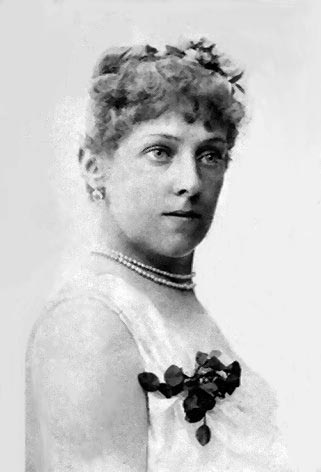
She succeeded to marry count Eugen Visconti, C7, offspring of an Italian noble family, who was engaged at diplomatic service as Vice-Director of the Department of Common Affairs of the Russian Ministry of Foreign Affairs (cf. Visconti ). His ancestors were known architects of Sanct-Peterbourg and its Imperial suburbs. C6 and C7 had no own children, therefore they adopted a girl who inherited their name: Alexandra (Sanda) Visconti, J3.
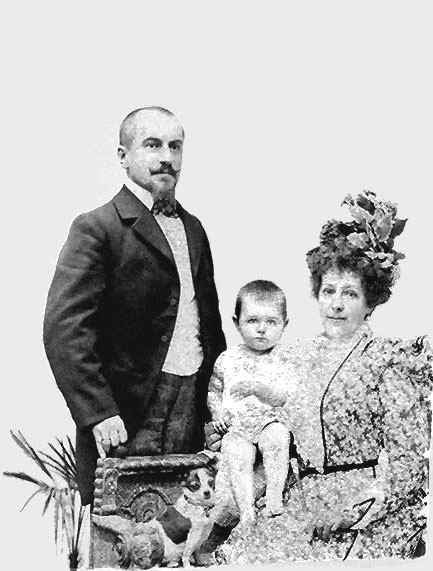
A number of photos survive showing all them with their small bitch Karinka.
The family of Visconti was admittable to salons of the higher class, was prosperous and had friends among political elite. One of the closest friends of C6 was Pokatilova, H4, wife of Ambassador Pokatilov.
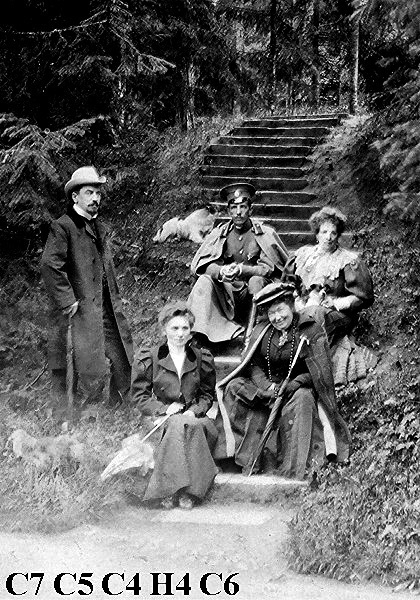
Together with Mrs. Pokatilova on the stairs of Old Silvia in Paulovsk.
C6 distinguished herself in generosity. Once she inquired famous orthodox priest Pater Johannes of Kronstadt how should she live in order to be saved. The priest answered: "Keep being as you are now". C6 died on 4, April 1930 after her husband had died in November 1929. This was almost a rule of that noble generation of normal peaceful times that those who had happily lived together in love, usually died together too. Their foster daughter J3 left the Town for Siberia, where her husband Nikolai Voronov, J4, lived, after the war and died there.
The eldest after C6 was Olga (1863), D1. She married a Russian Oparin and had 3 children. The name of one of them, JY, is forgotten (this is obviously a tall thin boy usually seen on photos with other children of D1). The 2 others were Eugen (Zhenka), J8, and Anna (Nyura), J9. They lived constantly in Gorodishche but D1 took care of her old father A6. J9 married Kishkin, a common Russian soldier of the Red Army, and went away elsewhere. The fate of Zhenka, J8, is not known either.
Feodore Ekimov, Martha Ekimov, Zhenka (below)
and Nyura (over) Oparin,
Olga Oparin, Anna Ekimov, JY in Gorodishche estate,
1900.
The latter was told about as if having been "inadequate". It was before 1917 (apparantly after the death of A6), when J8 left a burning candle on the loft and thus the whole house was burnt off.
Remaining inhabitants were sheltered by a neighbour friend, local veterinary Eudokimov. Eudokimov was later arrested for saying "anti-Soviet" anecdotes and beaten. He hanged himself in N.K.V.D. prison.
The last
2 daughters of A6 and A7 were Anna (1868), D2, and, Ludmilla
(1869-1945), the youngest, D3.
Ludmilla was very beautiful and famous as a “Queen of Balls”.
Ludmilla von Wagner.
She was married to a military cavalry officer Nicolas von Wagner and had 4 children: Olga, K0, Nikolai, K1, Constantin (Koka) K2, and Ludmilla (Lyolia), K3. During the World War II D3 evacuated to Alma-Ata, where she died in 1945. Descendants of K2 and K3 survive (see Von Wagner).
Of Anna, D2, is only known that her husband's name was Prozorowski. A Prorector of Sanct-Peterbourg university (ca. 1912 - 1915) with the same name is mentioned in the book by Prof. Dm. Likhachev Zametki i nabludeniya: Iz zapisnykh knizhek raznych let (Remarks and Obserbations: from Note-Books of Various Years. Sovetskij Pisatel: Leningrad 1989, p. 62).
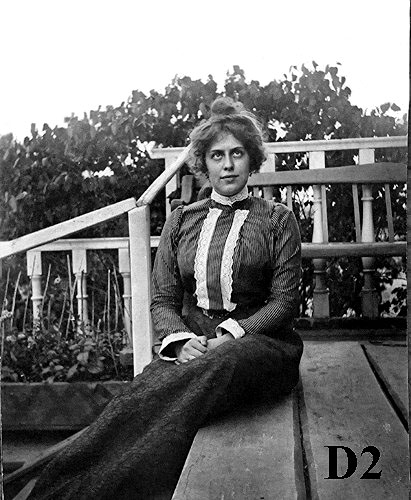
Anna in Gorodishche ca. 1900.
All following generations belong to dying (destroyed) Sanct-Peterbourg.
All children of C4 and C5 were born before 1917 (1903, 1905, 1906, 1912, the second child Nina died in the same year 1905). The eldest Basily (1903-1992), i7, finished the privileged Peterbourgian German school Peterschule, then studied at the Institute of Technologies and became a skilled first-class engineer.
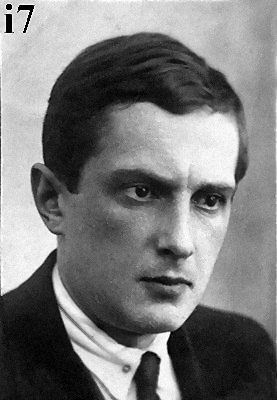
Photography was his hobby during
all his life. This was adopted by him from his father C4. He arranged a
photo-laboratory in a store-room of Konyushennaya flat. This laboratory was also
used by the next generation. Under Soviet conditions i7 was doomed to spend
almost all his life in 1 room together with his wife i8 and daughter R5. Only in
last 15 years he got a so-called "separate flat" what was in a block
building outside historic Peterbourg, i.e. corresponded to the poorest Western
standard. After ca. 10 years the family succeeded to come back to the centre,
but the new flat was factually his daughter' s R5 who already had 2 children at
that time. i7 died in poverty abandoned by his daughter but taken care of
by his devoted grandson painter Alexandre, Z4. Z4 is said to have
committed suicide on 25 November, 2000, in course of his arguing with his mother
R5.
The wife of i7 Nina (1908-1983), i8, was a remote descendant of Greek
ancestors. She was born in Libau (Liepaja, Latvia) in a big middle-class family
of Dvurechensky.
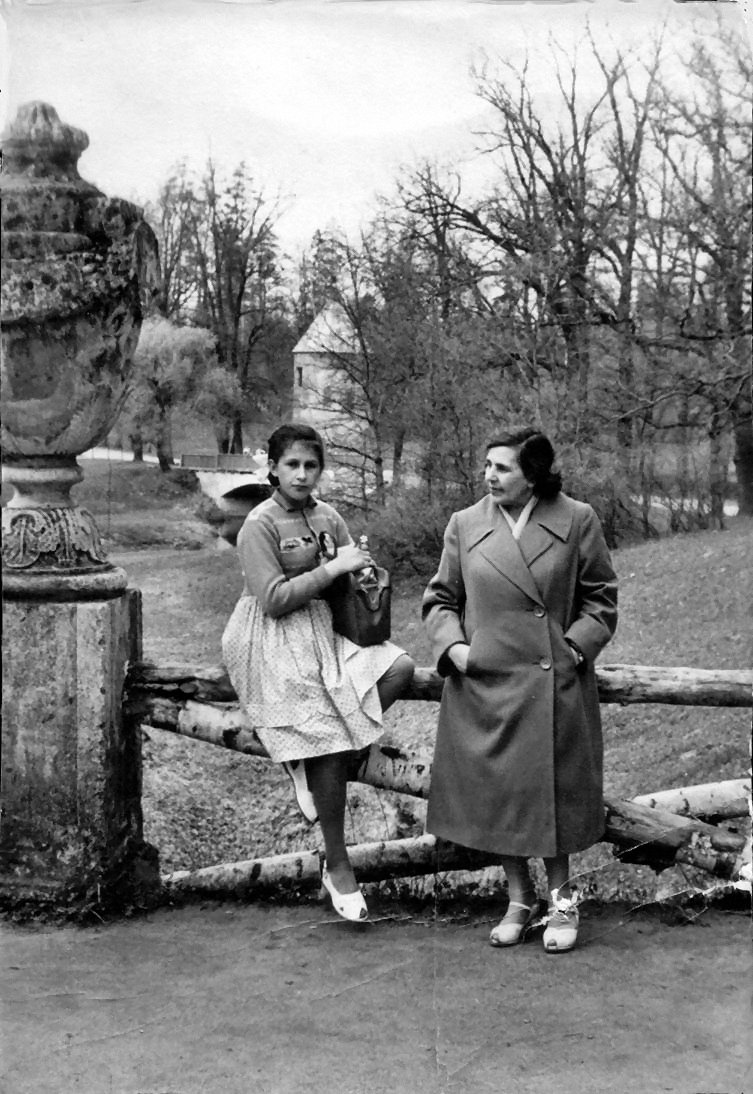
Toma, daughter of V. Ekimov together with her mother in Pailovsk. Ca. 1964.
i7 met her when being evacuated to Tbilisi during the war. Their 1st son Vladimir, R4, died of dysentery in 1946, not having survived a year.
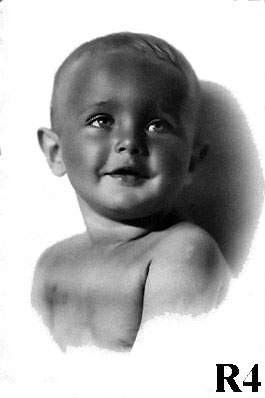
Fate of the middle son Vladimir (Lyodia, 1906-1996), H9, was more lucky. With all likelihood it was violinist Constantin.3 Klosse, F2, husband of F3, sister of C5, who perceived that H9 was gifted for music. The boy began his violinist career in his turn, but finally he graduated from Sanct-Peterbourg (then - Leningrad) conservatoire and was engaged at the same orchestra as F2 - in Maria Theatre.
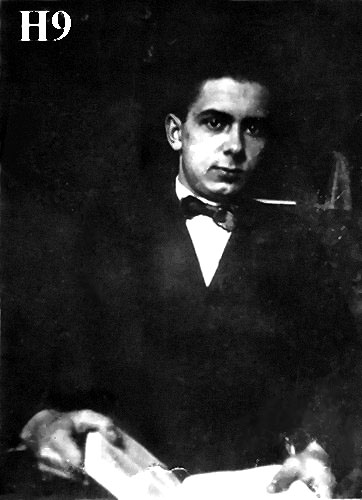
He spent there all his life finally
becoming assistant soloist of the orchestra. Not once he had to play
solo parts in main performances.
H9 was married to his colleague Nadezhda (Nadia, 1905-1995), i1, also a
violinist of the Maria Theatre orchestra, who was a descendant of Peterbourgian
Estonians from her father's side.
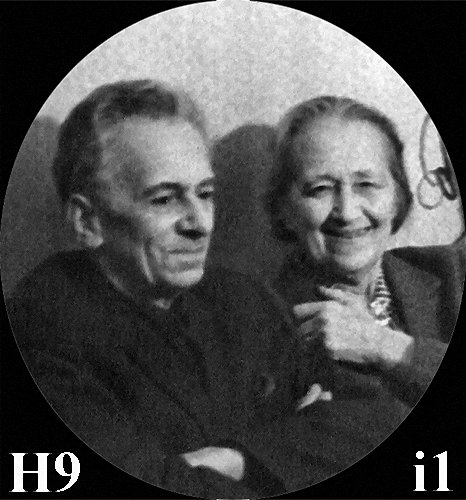
Her father Karp Elb,
G6, was a priest at the Orthodox Estonian church on Catherine-Canal. He was
arrested by N.K.V.D. on 27 August, 1937, and shot to death on 29 September,
1937, either in the prison of Kresty, where the Finno-Ugrian autochthons
of Ingria together with local Estonians were in mass liquidated at this time,
or with all probability in the prison on 4, Liteyny Ave., in Leningrad. In
Februar 2001 Pater Karp was canonised as an Orthodox Saint by the Synod
Commission for the Canonisation at the Moscow Patriarchy.
During the war, when the family of H9 was evacuated to Perm,
(then - Molotov),
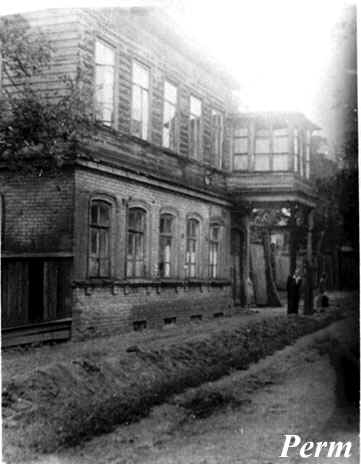
H9 travelled together with the orchestra from town to town with concerts, sometimes - in the front zone. These travels are described in his diary.
H9 and i1 had 2 children twins, Andrew (Yusha), R1, and Alexandra (Ina), Q8, born in 1937.
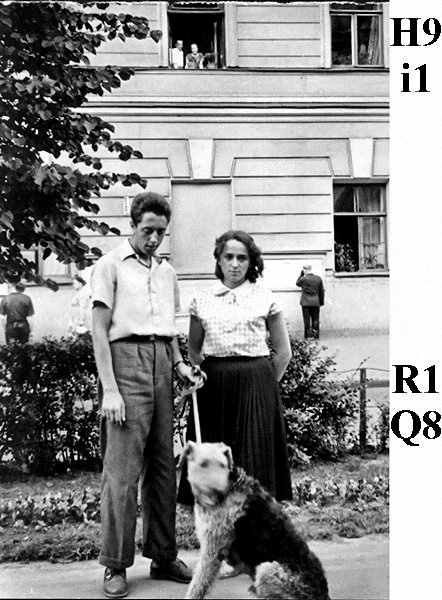
Andrew Ekimov, his parents Vladimir and
Nadezhda (in the window of the 1st floor)
and his sister
Alexandra with their dog Zeiss on Konyushennaya street. 1958.
They all 4 also lived in 1 room on Konyushennaya Str. until the children married. Nevertheless, H9 used a possibility to build a summer house in Estonia near Narva. They (nowadays - their descendants) made use of this house for relaxation in summer.
The last photo of Koka near Narva, his son's house being built there.
They also possessed a car - this all meant a high level of life in Soviet society of those times. Both H9 and i1 ended their life in the atmosphere of peace and mutual love created by them and their children at the old flat of C4 on Konyushennaya Str.
Of H9's friends a famous conductor Karl Eliasberg, O2, is to be mentioned. This friendship began in years of their common studies at the conservatoire.
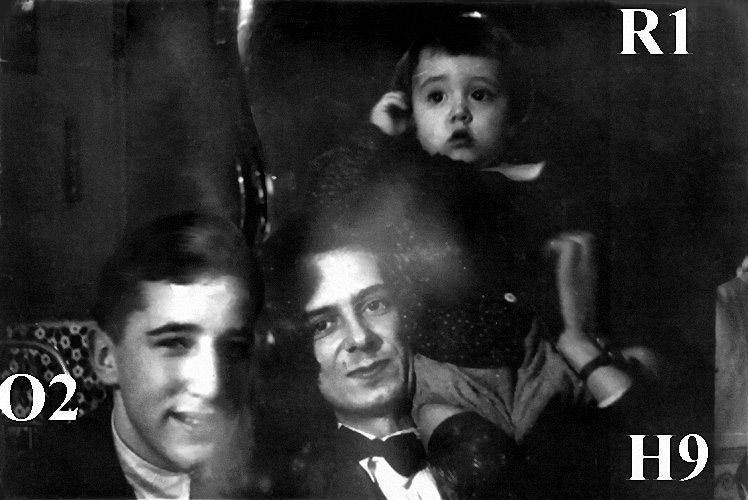
Karl Eliasberg and Vladimir Ekimov with his son
Andrew
in the "second" flat No 14 on Bolshaya Konyushennaya.
The youngest son of C4 Constantin (Kotia, 1912-2001), H7, with all probability was given this name not only to honour his father but also under the influence of Constantin.3 Klosse, F2.
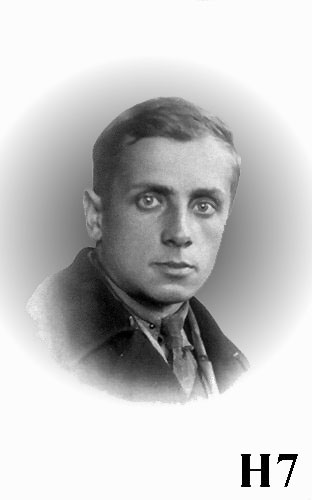
In his character he was more similar to i7 but distinguished himself with firm optimism and belief in Good. His Godmother was countess Olga von Reische-Ritt, in marriage Ermansson, G4.
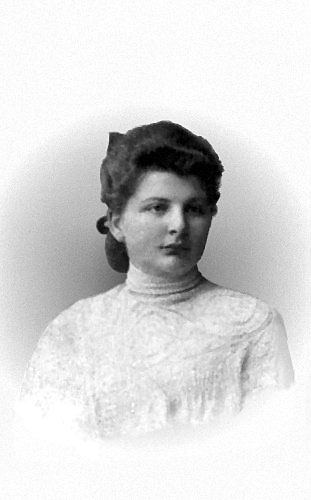
Her husband Ermansson was of Swedish origin. He was a military
officer who joined socialists-revolutioners (the "Esers") after 1917
and was executed to death by the Bolsheviks. Then G4 was sheltered for a short
time at C4's flat, where she lived in a tiny cell made of a part of former
corridor which led to the cut-off half of the former whole flat (there is a
bathroom there now). G4 was not restrained in expressing her views. Because of
her free utterances she was arrested and shot to death by N.K.V.D.
H7's way was harder since he had to struggle for himself under the anti-human
pressure of developed Stalinism. He was the
first child of C4 and C5 who went to the
Soviet school from the very beginning (the school was in the building of an
old gymnasium on Kazanskaya str. not far from the house of Visconti).
Not permitted to enter a high school because
of his "social origins", he began as a worker at Chemical Gas
Factory. Once he experienced an accident there when in a lucky way he
succeeded to save his eye, sprayed with sulphuric acid, by rinsing it with water
from a nearby tap. In 1 year he achieved the highest professional category. This
allowed him to be admitted to the Mining Institute
(1932-1936). It was Khibinogorsk where he worked as a trainée. After the
Institute he was mobilised to Baltic Navy and after a year became
a lieutenant. Demobilised, he was engaged as senior mechanical engineer at Baltic
Works. Then he married a niece of Constantin.3 Klosse Tatiana (1910-1968),
H8, of whom he and his brothers made their acquaintance much earlier while
spending summers at the house of F3 and F2 in Novgorod on Slavnaya
str. No 14. H8, while being granddaughter of
Constantin.3 Klosse's mother Laura, B4, shared part of the latter's legacy in
the neighbouring house No 12 together with her brothers.
In Sct.-Peterbourg H8 dwelled on
Malaya Konyushennaya Str. parallel to Bolshaya Konyushennaya. This was
the last flat rented by her father Gregory Tarasenko, F8,
viola player of the Royal Philharmonic Orchestra, a Ukrainian (see Tarasenko).
After her father's death in 1934 H8 lived in solitude which was alleviated
mostly by her friends and her godmother Alice Kötzberg, G5. The
latter was engaged at a meteorology station in Bolotnaya, far from
Peterbourg, but H8 used to visit her every summer.
C4 and C5 hoped this handsome girl becomes wife of their eldest son i7
(future wife of H9 being i1). i7 and H8 really were and
remained good friends, but H7 unexpectedly outrun his eldest brother: a civil
wedding of H8 and H7 took place on 18 April, 1938. This was celebrated on Bolshaya Konyushennaya Str.,
where almost all remaining members of once flourishing Ekimov-Visconti clan met
together. In 3 years comes the war after which D5 and the whole his family
disappears, as well as L1, the soul of this company, and J3, the foster-daughter
of Visconti. After 1914 Sct.-Peterbourg and its remnants was consistently
destroyed by united Russian and Western forces.
On the said day there was another
young pair at the table too, H9 and i1, who had been in marriage already for 2
years. Thus this was the last big party of the clan before its final
destruction.
After their marriage H7 and H8 first dwelled in H8's room in the former last
flat of F8 on Malaya Konyushennaya Str. (this flat, similarly to almost all
flats in Sct.-Peterbourg, was converted into a hostel by Bolshevik authorities
who settled thousands of new-comers from all parts of the U.S.S.R. in this
industrial town), but soon they moved to the former flat No. 27 of H8's
uncle Constantin.3 Klosse, F2, on the 5th
floor on 54, Officerskaya
(after 1917 - Decembrists') str. (former
house of Estonian Lutheran Community), where 2 of 5 rooms were left to the
spouses F2 and F3. The latter hosted the newly-weds in the smaller room but
dwelled in the bigger room which was part of the former salon (the remaining
part having been separated with a new common corridor).
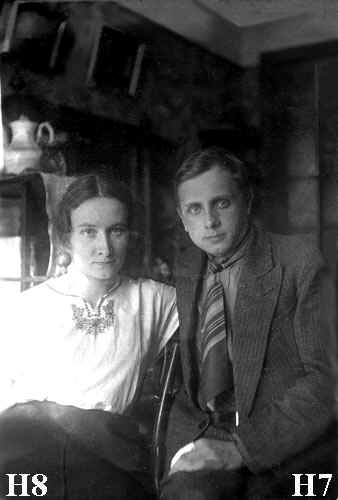
Tatiana and Constantin in the smaller room. 1938.
On 1 May, 1939, C.Klosse, F2 died. Then H7 and H8 changed the rooms with the widowed F3 and moved into the bigger room. This was ca. 28 m2 space and was part of the former salon, the remaining part with the former fireplace cut off and converted into a dark corridor from the entrance to the last room, WC, bath-room and kitchen at the "black" staircase. A rounded high heating-stove was erected in the corner. Of course, no property documents were needed: all property belonged to the state, the tenants only had to struggle for getting right of the so-called "prescription", i.e. official registration. "Space" "belonged" to those who were registered.
Since 1938 H7 was a
post-graduate student at the
Mining Institute, the studies interrupted with the mobilisation to the
war against Finland in 1939-1940. Good luck, he escaped participation in
predatory actions in Finland and again was taken to coast defence at the fort Krasnaya Gorka,
where he was promoted to the rank of captain. Unfortunately, the shame of the
"participant of the Finland war" overtook him on pension, in 1999.
After the demobilisation H7 became engineer of mechanics of forging press shops
at Kirov (former Putilov) Plant. He was engaged there
during the war including the whole period of the blockade, as well as after the
war till 1953 when he came back to the
Mining Institute.
During the war not only he himself but also his wife H8 remained in the blockaged
town. A bigger ration of bread due to responsible duties at Kirov plant, which
had been turned into a fortress, saved H7 from starvation, similarly to his H8,
who was saved thanks to her work of a doctor at a military hospital in Ozerki.
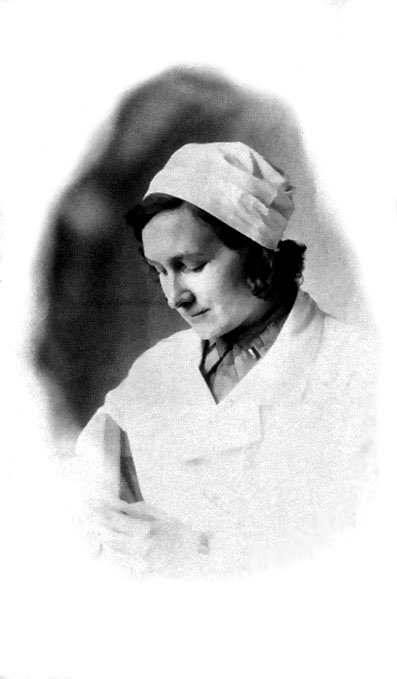
The plant was at the southern boundary
of the town, while Ozerki was in its northern outskirts. Officerskaya street was
somewhere in the middle. No city transport existed. In order to meet themselves,
one had to go on foot more than 12 km through long deserted snow-bounded
streets, being hungry, not to say about regular shelling and bombing. Corpses
were seen here and there. Nevertheless they preferred to spend free hours in
Ozerki, because the flat on the upper storey on Officerskaya was especially
unsafe in bombing and shelling. Although H7 was much less Sovietised than his
wife, his mentality was conditioned by fear and indoctrination too. Therefore it
was not accidental that the both applied for acceptance for the Bolshevik party
when the war began. This was a sign of their real Soviet patriotism.
After the birth and death of their first child in 1940, they had no children
until Q3 was born on 14 May, 1944, in recently deblockaged town. After the war
the health of H8, who had experienced famine already in her childhood, was
shaken and constantly got worse. She died of riticulosis in the age of 58. At
that time H7 made his academic career and became doctor and a docent at the Institute
of Mechanics where he had passed after having been assistant lecturer at
the Mining Institute in 1953-1957 (at the latter period he was also parallel
engaged at the Food-Industry Technicum). After retiring on a pension in
1983 H7 moved to his son to Lithuania where he still succeeded to be engaged at Kaunas
Radio Factory for several years. He spent his last days in the company of
his granddaughters Y1, Y2, Y3 amidst the old furniture taken from Sct.-Peterbourg.
This home in Lithuania was much more Peterbourg-like than what remained in
profaned Leningrad.
5 friends of H7 cannot be forgotten.
H7's school-mate Ilia Zagnaev, O3, was the closest among them.
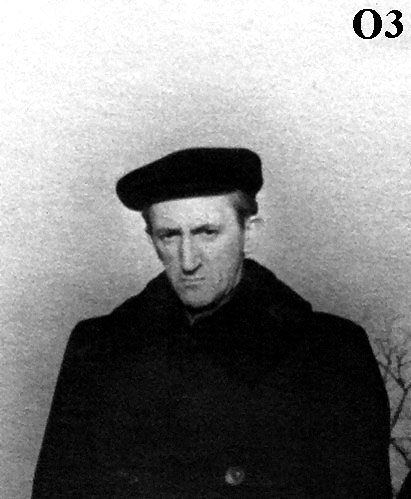
He named H7 Kostia, not Kotia,
as it was usual among relatives. O3 spoke slowly in a low voice. He was a
typical Jewish idealist with extraordinary good heart. He was an engineer whose
hobby was inventing tools improving mechanical drawing. He also collected and
used to cite rhymed aphorisms of Oriental (mostly - Central Asian) wisdom,
e.g. Kakoe b ni bylo tvoe stremlenye, khot shag ty sdelay v etom napravlenyi
('Whatever aspiration you have, you should make at least a step in this
direction'). He was single all his life and was strongly laughed at as a
"funny Jew" for his peculiar character and absence of practical
orientation in reality. His constant critic was his brother Moyses, whose wife
hated O3, but the latter found support in his old mother Polina Moiseevna,
a widow of a Peterbourg Rabbi. He lived with her in a small room with windows
looking to Old Peterbourg backyard, but the family of his brother occupied the
opposite, street-side, of the flat. A friend coming to them first heard cheerful
exclamations of Polina Moiseevna Kakeeye gostee! Kakeeye gostee! ('What for great guests!'). There were also some celebration parties together
with brother's family when a guest had a pleasant opportunity to enjoy
traditional Jewish dishes perfectly made by the old mother. After her death O3
lived very short and fell ill. He presented to H7 an old big etching of A.Böcklin
and their old family table-knife with the initials AC. O3 died on 20
June, 1976, and was cremated. At the funeral ceremony his brother said about O3
in a didactic way: This life was useless. Each saint life is
"useless" because it does not exploit other lives to produce material
values. Zagnaevs' house was a shade of Old Sct.-Peterbourg, finishing the
perspective of Kazanskaya Str. from the side of Nevsky Prospect. The
house has been brutally pulled down in recent decades together with the local
Peterbourg spirit of the surroundings as well as the memory of Peterbourg Rabbi Nahim
Zagnaev, his wife and descendants.
Other 2 friends of H7 were Georgians, the institute-mates Alexandre Khvedeliani, O5, and Arsen Imerlishvili, O4. The latter remained in blockaged Leningrad together with his small son.
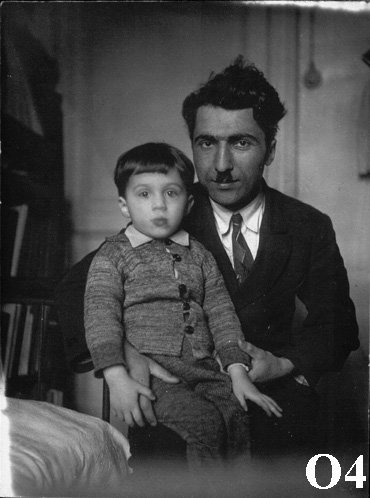
They dwelled not far from Zagnaev. Both
perished when a bomb hit their house on the Theatres Square.
The way of O5 separated even before the war when he left for Georgia after
finishing the Mining Institute.
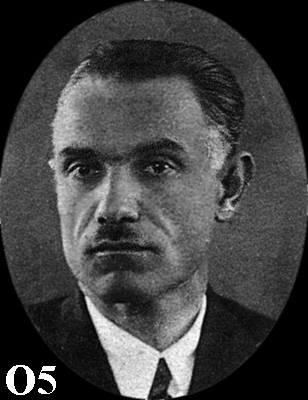
Q3 still met him before death in
Tbilisi in the seventies, but next year, when H7 himself came to Georgia, O5 had
already died. H7 recalled O5 being a slow-coach person (in fact the name Khvedeliani
is of Svanish origin, but the Svanians are Georgian mountaineers, i.e.
"northerners").
The fourth close friend of H7 was Ethnic Russian Alexandre Silichev, O6, of the post-war period.
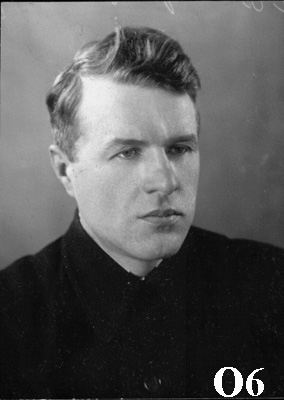
O6 was a mechanician at Kirov
Plant with whom H7 patented a number of inventions. One of the first
significant inventions was a hydraulic toggle forging
press with an operated table (patented under No 99458 on 4 June
1951 by the Ministry of Building and of the Industry of Instruments of the
USSR), but the last significant invention was a spheroidal motion
presser , conceived by A.Silichev and patented together with H7 as
well as with R.Babushkin and A.Pekhota (under No 412969 on 5
October 1973 (!) by the Committee for the Inventions and Discoveries at
Council of Ministers of the USSR to the request of 20 December 1971!).
On the basis of this project H7 wrote and defended his doctor theses yet in 1968
(!). Later the presser was used as a rationalising element in improving
various mechanisms, what was proposed by H7 together with N.Ageev a.o.
without A.Silichev (5 patents more). It was only absurd awkwardness of idiotic
Russian bureaucracy that the invention of the spheroidal motion presser had
been introduced into Western production earlier than it was patented in the
USSR! No doubt, in the West its "authors" profited by the occasion
with huge honoraria while O6 and H7 died in poverty. Soon a today popular
stirring water tap was produced in the West on the principle of the spheroidal
motion - God alone will not forget who was author of this idea! In his last
years H7 used to name this tap "spheroidal presser" in
ironical manner. He even had not enough money to buy such a tap for his
family. As for O6, he lived inventing till his last days. He took interest in
everything including flying toy devices. Such persons become multi-millionaires
in non-criminal countries which in their turn become prosperous due to such
persons, because "ordinary citizens" are regarded to be people
there and are not blown up together with their houses by special
services for authorising terrorist war against Chechnya. O6's father was in
some way connected to Tzarskoe Selo
- it seems as if he was an electrician of Catharine's Palace there
before and (this is true) after 1917. O6's spouse Anastasia
distinguished herself with regular features (Q3 even noticed that women of
this type were met in Northern Lithuania). She seems to have originated
from Ukraine. After the war during all her active life she was engaged
as saleswoman at Leningrad Trade House (so called DLT ) on
Bolshaya Konyushennaya. They had no children. News about the death of O6 and his
wife appeared to be a terrible blow for H7 and hastened his own death.
The fifth friend, Ruzalit Suleimanov, OO, was the youngest. He originates from Orenburg and lives there with all his family.
Ruzalit Suleimanov (2nd from the
right above) with students and members of the LMI Chair of the processing of
metals by pressure (Constantin Ekimov sitting in the 1st row, 2nd
from the right. Further over
a one - N.Ageev), 1968.
He was a student of H7 at the Institute of Mechanics, remained a thankful pupil who did not forget his teacher after the latter's death.
Westernised Peterbourg kin of Ekimov is damned to vanish: no more male descendants of A6 will be born in future. They disappear after their European Town.
The kin of Ekimov is related to that of Klosse
through the marriages of: 1) C4 and C5 > 2) F3 and F2,
3) H7 and H8.
The kin of Ekimov is related to that of Henkel
through the marriage of
C4 and C5.
The kin of Ekimov is related to that of Tarasenko
through the marriage of F7
and F8.
The kin of Ekimov is related to that of Visconti
through the marriage of
C6 and C7.
The kin of Ekimov is related to that of Von Wagner
through the marriage of
D3 and DD.
